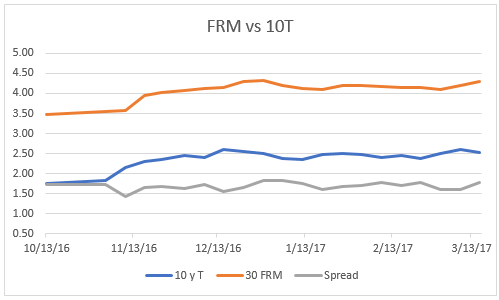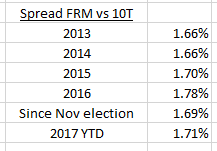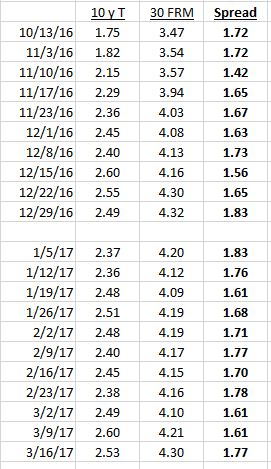Are mortgage rates headed higher?
For the third time since December 2015 the Federal Reserve (Fed) increased interest rates this week. The increase, like the two prior ones, was 1/4%. What does this mean for mortgage rates? The key is to understand which rates are impacted by the Fed Funds (FF) rate and which are dependent upon interest rates set by the market.
Which rates are based upon the Fed Funds rate?
30 year fixed rate mortgages (FRN) are not based on the FF rate, but are most closely tied to the yield on 10 year US Treasuries(10T). More on that in a minute.
The prime rate directly follows the FF rate, is set by banks and is consistently at a margin of 3% above the FF rate. Immediately after the increase in the FF rate, all the major banks raised their prime rates from 3.75% to 4.00%.
Interest rates which follow prime rate are home equity lines of credit (HELOC), credit cards and auto loans. The only direct property-related impact is on HELOCs. Note the difference between home equity loans – which are for a fixed amount at a fixed interest rate – and HELOCs, which are for a varying amount at an interest rate which varies with the prime rate. The interest rate on a HELOC is normally stated as “prime plus (or minus) x per cent”, so the interest rate on these will increase immediately.
Fixed Rate Mortgages
FRM rates are set by individual banks and are dictated by market conditions. Most conforming mortgages are sold to investors in the form of mortgage-backed securities. The yield demanded by investors is most closely linked to a premium (spread) over the yield on US Treasury 10 year Notes (10T). The yield on 10T is often seen as an indication of the strength of the US economy, although it can also be influenced by geo-political factors which can cause a flight to safety (foreign buying of US Treasuries) in times of uncertainty.
When the Fed first increased rates in December 2015, the yield on 10T was around 2.25%. In my comment I wrote: “If commodity prices remain weak, there will be a significant deflationary impact felt in several countries; China’s slowdown could continue to be a drag; and of course there is always the risk of a major war or confrontation. The US economy is doing quite well, but will not be immune to what is happening elsewhere in the world.” At the time of writing nobody had coined the phrase Brexit, the impact of which in June 2016 caused a flight to quality which drove the yield on 10T down to 1.4% and FRN to under 3.5%.
By the time of the November Election the yield on 10T was around 1.85%. In Why the Election drove mortgage rates up I explained the reasons for the post-Election spike to 2.6%. Consequently, the FRM jumped to 4.32% in December, very close to this week’s 4.30%.
How are Fixed Rate Mortgages priced?
Investors in mortgage-backed securities demand a premium over the yield on 10T. I monitor the spread – the difference between the two yields. First, I show the average since 2013:
The increase in 2016 reflected the period in the summer of that year post Brexit when the yield on 10T dropped sharply for geo-political reasons. The mortgage rates did not follow as closely as demand for mortgages remained strong along with the US housing market. Other than the summer of 2016 the spread has been consistent for the last several years, averaging 1.70% since 2013.
What has happened to rates since the Election?
Immediately after the Election the yield on 10T started climbing, reaching 2.6% by the day after the Fed increased rates in the middle of December. Since then, the yield has been as low as 2.31% and as high as 2.62% before falling back to 2.5% after the latest Fed rate increase. Note, however, that despite all the very active news in 2017 and despite the Fed rate increases, the spread of FRM over 10T has averaged 1.71% so far in 2017, in line with the average for the last several years.

Will mortgage rates increase further in 2017?
The Fed expected to increase short-term rates 3 times in 2016 as the economy expanded and inflation started to pick up. This did not happen and there was only the one increase late in the year. The Fed is again forecasting 3 rate increases in 2017, and there is a general expectation that the US will see both faster economic growth and higher inflation in 2017. If these occur, then the Fed’s forecast may well turn out to be correct. The markets certainly expect it to be.
If the Fed is right, it is likely that both employment levels and wage growth, along with inflation, will be continuing to demonstrate growth. In that case the yield on the key 10 year Treasury will increase somewhat and it is that which will lead to higher fixed rate mortgage rates. On the other hand, the strength of the US dollar will serve to dampen inflation, while fear of the impact on the dollar may cause the Fed to be less aggressive in raising rates. While business confidence has increased sharply since the Election, it is unlikely that any possible tax cuts will have an impact on economic growth in 2017.
As an aside, my favorite economist, Brian Reading, was once introduced at a conference (by me) as a “one-handed economist”. That’s because most economists say “on the one hand….. but on the other” whilst Brian made a specific forecast – which usually turned out to be correct.
Overall it seems quite possible that we will see forecasts that the yield on 10T will increase to 2.75-3.0% in 2017 and that in turn suggests that FRM could increase to 4.5-4.75%.
What could happen to cause mortgage rates not to rise?
The Election changed the outlook for growth and inflation in 2017, not just because Mr.Trump was elected President but because the Republican Party retained control of Congress, indicating that its pro-growth fiscal policies would likely be enacted into law. That was the basis for the sharp jump in the stock market and the sharp fall in the bond market, causing yields to spike. The downside risks to the optimistic forecasts for 2017 are that fiscal policy ( tax cuts, less regulation) gets delayed or bogged down in the other “stuff” going on, or that a major geopolitical event occurs somewhere in the world.
At this stage, however, a one-handed economist would say that we will see further increases in FRM in 2017.
Mortgages are still cheap
The guessing game – or forecasting, as economists like to describe it – of what will happen in 2017 should not disguise the basic fact that mortgage rates
today are historically cheap – and may not be as cheap in the months and years ahead. The first chart shows the decline in FRM over the last 25 years:
source: tradingeconomics.com
And now the last 5 years – note that the FRM did not drop below 4% until 2012:
source: tradingeconomics.com
Adjustable Rate Mortgages (ARM)
Throughout the years of declining rates ARMs have been a very successful financing mechanism for those who understand the risks. With the change in outlook for mortgage rates, as highlighted in my Is this the end of ultra cheap mortgages? report right after the Election, it is a good time to look at ARMs for those who understand that ARMs can be a useful part of overall financial planning. Note that the 5/1 ARM rate this week was a full 1% below that of the FRM.
Are you thinking of selling your home? If so please contact me on 617.834.8205 or Andrew.Oliver@SothebysRealty.com for a free market analysis and explanation of the outstanding marketing program I offer.
Not sure which broker to use to sell your home? Read Which broker should I choose to sell my house?
If you are looking to buy, I will contact you immediately when a house that meets your needs is available. In this market you need to have somebody looking after your interests.
Andrew Oliver is a Realtor with Harborside Sotheby’s International Realty. Each Office Is Independently Owned and Operated
@OliverReports


